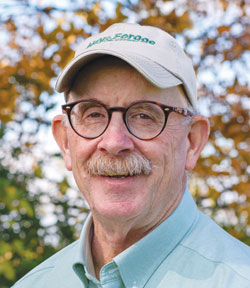
Mike Rankin
Two roads diverged in a wood, and I — I took the one less traveled by, And that has made all the difference.
— “The Road Not Taken” by Robert Frost
Choices: We make them every day. Some seem big, others less significant, but only time can truly measure the magnitude of choice outcomes.
When large square and large round balers were introduced, many haymakers made the decision to relegate their small square baler to the scrap heap along with the need for excessive manual labor. The eventual demise of the small square bale was widely predicted.
Like many kids who grew up or worked on farms, I have the methodic and rhythmic sounds of the plunger, needles, and knotters stamped on my brain. Those were the days of flat racks, bale-kicker wagons, and hay elevators. These tools of the trade no longer define the small square bale enterprise as they once did.
To be sure, large hay packages dominate the rural landscape, but the small square bale has somehow remained relevant. This is so because some haymakers have refused to let small square bales die a slow death. In doing so, they took it upon themselves to design and build tools and implements that removed sweat labor out of small square bale production. These days, farmers who produce large numbers of small square bales have mechanized the enterprise from field to customer. Hay hooks are left hanging on the wall.
The ability of the small square bale to remain a viable commodity has resulted in something that I think many people thought would never happen. After more than 30 years of essentially zero research and development in small square balers, multiple farm machinery manufacturers are now marketing or will soon offer balers with significant technological advances, ranging from on-board flake counters to double balers. There are also smaller companies marketing tech tools and hardware that further enhance baling operations. This type of investment was thought inconceivable only a few short years ago.
Perhaps a pertinent question to ask is: What is sustaining a viable — and perhaps growing — small square bale industry?
I think the answer comes down to one animal species — horses, or more specifically, horse owners. Small ruminant markets also play a role. For haymakers who have stuck with the small square bale market, they have experienced a steady demand from an equine and retail feed supply market that much prefers bales that accommodate close human interaction.
In the March issue of Hay & Forage Grower, Krista Lea from the University of Kentucky reported on a recent national survey of horse owners. Respondents ranked bale size as the third most important factor when purchasing hay. Bale size, with small square bales preferred, followed only hay price and dealer reputation as the top three considerations. Many hobby farms don’t have the space or equipment to deal with large hay packages, and they’re willing to pay for the convenience of smaller bales.
Although there are many individual horse owners who buy direct from the hay producer, there is also a large retail feed supply and racetrack market for small square bales. These markets can be lucrative. A past study published in the Agronomy Journal found that small square bales sold, on average, for $105 more per ton than their large round bale counterparts over a period of years at one Kentucky auction.
In the Western states, three-tie bales remain a common commodity and are desired by not only horse owners, of which there are many, but also export customers. Many commercial hay producers in the West split their production into large square bales and small three-tie bales. Slicing and dicing large square bales into small-bale bundles is also common.
These days, technology now offers multiple options in various price ranges to collect and stack small square bales out of the field. There are even easy methods for loading flatbed and van semitrailers without hand labor. It’s these handling innovations that have largely kept the small square bale industry viable for the producer and reduced the massive labor requirement of years gone by.
Small square bales will never dominate the hay market, but it’s also not time to issue last rites. If it was, equipment companies wouldn’t be investing in the enterprise. Hay producers who have chosen to traverse the small square road will continue to profit from a lucrative niche market.
Happy foraging,

This article appeared in the April/May 2023 issue of Hay & Forage Grower on page 4.
Not a subscriber? Click to get the print magazine.

